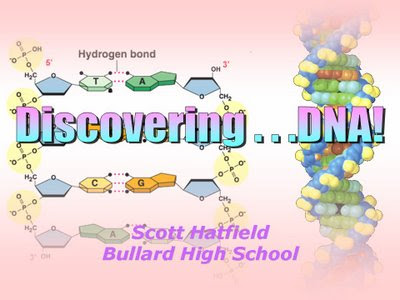Summer School Biology students today viewed a 36-minute IMAX video in class and completing a worksheet based on part of the video. The film,
'Cosmic Voyage', was made in 1996 for the Smithsonian Institute and was clearly inspired by a classic science education film called
'Powers of Ten', originally produced in 1977 by the husband-and-wife team of Rae and Charles Eames.
'Cosmic Voyage' approaches the idea of using the metric system, which is based on powers of ten, to explore the question: "What is really large, and really small?" The film first zooms out from an acrobat's ring in
St. Mark's Square in Venice, the place where Galileo first trained his telescope on the heavens.

Through 23 powers of ten, we leave first the Earth, then our solar system, then the Milky Way Galaxy behind, until we reach the limit of modern astronomy, where we can see images from about 13 billion years past.

Reversing course, the video then zooms in on drop of water in the Dutch town of Delft, where
Antonie Van Leuuwenhoek first trained his early microscope to discover the hidden world of microbes.

As we zoom in on a paramecium, we penetrate its cell nucleus, then zoom in on a molecule of DNA.

Within that molecule is a carbon atom, and the world within that atom is mostly empty space! Within the atom, the atomic nucleus contains virtually all of an atom's mass, made of particles called protons and neutrons. These, in turn, are formed from even smaller particles called quarks.
The film continues with a discussion of the search for a fundamental theory in physics through the use of particle accelerators like Fermilab, along with an overview of the likely "recent" events that led to our sun, our solar system, the Earth and life itself.
Here, presented on YouTube, is the first segment
(Chapter 1) of the film who wish to review the material or share it with others. As the narrator (Morgan Freeman) intones, 'we are all travelers on a voyage of discovery!'
Chapter 2, Chapter 3 and
Chapter 4 can be assessed at YouTube directly or by clicking on the hyperlinks.
Meanwhile...

KEEP IN MIND...this summer, in Mr. Hatfield's Classes, we will try to reduce the amount of class time spent taking notes. There are dozens of standards to cover, hundreds of vocabulary terms and other items to master. We need to decrease the amount of time spent in lecture so students can have more time to do activities. Remember: we want to engage as many different parts of the brain as possible, and to do that, we need to have more time to do things other than notes.

At the same time,
your Cornell Notes must be complete (all the notes, original questions and comments in the margins, your name/date/course on every page, and summaries of major sections of notes).
Therefore, it is the student's responsibility to download and complete any notes that they were not able to finish in class!!
THE NATURE OF SCIENCE
















